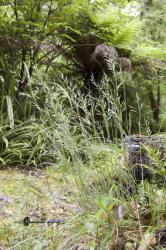- Taxon
- Gallery
- ≡ Danthonia gracilis Hook.f., Bot. Antarct. Voy. II. (Fl. Nov.-Zel.) Part I, 303, t. 69B (1853)
- ≡ Danthonia semiannularis var. gracilis (Hook.f.) Hook.f., Handb. New Zealand Fl. 333 (1864)
- ≡ Notodanthonia gracilis (Hook.f.) Zotov, New Zealand J. Bot. 1: 123 (1963)
- ≡ Thonandia gracilis (Hook.f.) H.P.Linder (1996) nom. illeg.
Tufts leafy, bright green, sometimes stoloniferous with prostrate culms rooting and sending up new tufts; leaves about ½ length of culms; branching extravaginal. Leaf-sheath light brown often purplish, scattered soft fine hairs towards collar or sometimes throughout, or quite glabrous; apical tuft of hairs (2)–3–4–(6) mm. Ligule (0.2)–0.4–0.7–(1) mm. Leaf-blade up to 25–(50) cm, flat with ± inrolled margins, 2–(4) mm wide, or completely inrolled, glabrous or often a few scattered long hairs near collar, sometimes almost all leaves with some long hairs throughout, margins finely scabrid. Culm to 50–(75) cm, internodes smooth but minutely scabrid below inflorescence. Panicle erect to ± loose and drooping from above, to 10–(14) cm, spikelets numerous on short pedicels; rachis and pedicels densely short-scabrid, occasionally with 1–2 longer hairs at branch axils. Spikelets 3–4–(6)-flowered, awns exserted from glumes. Glumes sometimes variously purple-tinged, lanceolate, acute to acuminate, 7–10–(12) mm; lower 5–7-nerved, upper (3)–5-nerved. Lemma 1.6–2.8 mm, 9-nerved, upper row of hairs continuous, ≈ lemma lobes, lower row not always well-defined and not reaching upper, elsewhere covered in numerous short hairs; lobes 2.5–4.5 mm, finely short-awned at tip; central awn 4.5–8.5–(9) mm, column 0.5–1.2 mm ≤ palea, « upper lemma hairs. Palea 2.5–4 mm, « upper lemma hairs, interkeel hairs few, margins long-hairy. Callus 0.3–0.5 mm, marginal hair tufts not reaching lower lemma hairs or scarcely overlapping them. Rachilla 0.4–1 mm, often with minute hairs at apex. Anthers 0.5–1.3 mm. Caryopsis 0.9–1.4 × 0.5–0.8 mm; embryo 0.4–0.6 mm; hilum 0.2–0.3 mm. 2n= 24. Plate 12I.
[From: Edgar and Connor (2000) Flora of New Zealand. Volume 5 (second printing).]




